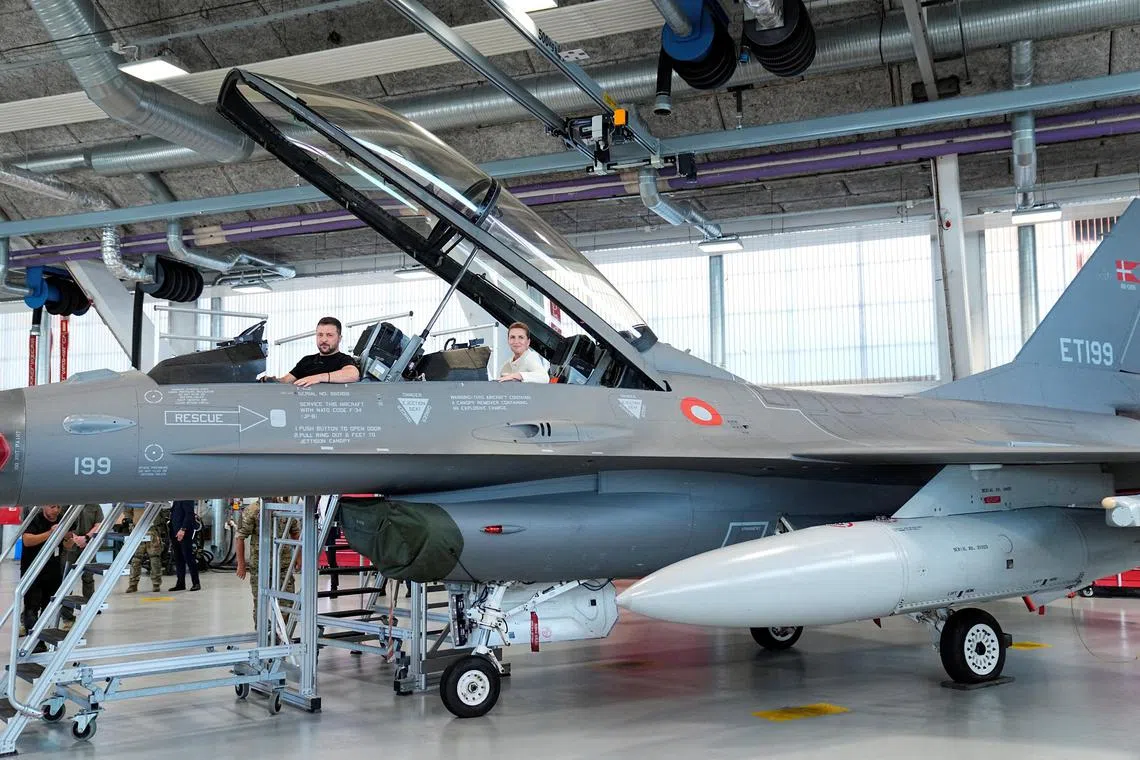Russian strikes raise concerns over Ukraine’s imminent F-16s
Sign up now: Get ST's newsletters delivered to your inbox

Ukrainian President Volodymyr Zelensky (left) and Danish Prime Minister Mette Frederiksen sitting in a F-16 fighter jet in Vojens, Denmark, in August 2023.
PHOTO: REUTERS
Follow topic:
WARSAW - Russia’s claims to have struck three Ukrainian airbases in as many days has exposed gaping holes in Kyiv’s air defence capabilities and triggered questions over how it will protect a fleet of F-16 fighters due to arrive in the country.
Alongside equipment losses, the Russian strikes this week
Moscow’s Defence Ministry said it destroyed at least six Ukrainian planes and a helicopter in missile strikes on three separate bases this week, publishing drone reconnaissance footage of the strikes.
In the most serious strike, it claimed five Ukrainian Su-27 fighter jets were destroyed at the Myrgorod base in the Poltava region, around 150km from the border with Russia.
It also said an Iskander missile hit a parked Mi-24 army helicopter, and a MiG-29 was destroyed in an attack on an airbase in Dolgintsevo, around 100km behind the front line.
“The main problem is the lack of very-short and short (range) air defence,” said Mr Konrad Muzyka, director of Rochan Consulting, an open-source analysis group studying the conflict.
“It prevents Ukraine from being able to shoot down Russian drones,” he added.
That means Russia can fly reconnaissance drones deep into Ukrainian territory to secure live intelligence and coordinates for missile strikes.
‘Make a choice’
In all three of this week’s strikes, Russia’s Defence Ministry published videos shot by drones of the hits and their aftermath – demonstrating not only their ability to fly them far into Ukrainian territory, but that they could stay hovering, undetected, long enough to transmit precise location data.
Moscow may have used a second drone as a “remote control relay” to increase the range of the craft scoping out the targets, a European defence industry source told AFP, speaking on condition of anonymity.
That Ukraine also failed to thwart the incoming missiles using Western air defence systems like the Patriot, IRIS-T or SAMP/T further demonstrated Kyiv’s long-standing complaints about a lack of firepower.
Ukraine’s President Volodymyr Zelensky has for months said his country does not have enough air defence systems to protect Ukrainian cities from incoming Russian missiles, pleading with Western partners to increase deliveries.
He has said Ukraine needs at least seven more Patriot batteries to halt the Russian bombardments.
“Ukraine has a limited number of long-range systems, and they need to prioritise. They are not able to cover cities, critical infrastructure and airbases. They probably had to make a choice to leave some areas undefended,” Mr Muzyka told AFP.
‘Control the skies’
Following Kyiv’s lacklustre 2023 counter-offensive, Ukraine pointed to its lack of air superiority as a major factor limiting its army’s ability to advance on the battlefield.
“In 2024, of course the priority is to throw Russia from the skies,” Foreign Minister Dmytro Kuleba said in an address to the World Economic Forum in Davos,Switzerland, in February.
“Because the one who controls the skies will define when and how the war will end,” he said.
Ukraine sees the imminent delivery of advanced F-16 fighters, promised by several Nato countries, as a major part of that puzzle.
Russia has promised to target and destroy any F-16s delivered to Ukraine.
“The latest strikes are not game changers, but they are a worrying signal, and they underline Russia is preparing to counter the deployment of F-16s,” said Mr Alessandro Marrone, a defence analyst at the Istituto Affari Internazionali, an Italian think-tank.
“In Europe, there are high expectations on F-16 deliveries, but we should be cautious in assessing the risks for these assets both during air sorties and their stationing in Ukrainian airfields,” he added.
The first deliveries, including from the Netherlands, Belgium and Denmark, are expected to arrive in the country imminently.
Some in Ukraine have criticised army commanders for leaving the planes that were hit in this week’s strikes unprotected and out in the open.
“If we keep losing aircraft in this way, no one will give us more,” said Ukrainian MP Roman Kostenko, who heads the Parliament’s security, defence and intelligence committee.
But he admitted there was no easy solution, saying concrete shelters would not protect against a missile packed with explosives.
Mr Muzyka said Kyiv will probably have to re-station F-16s quite frequently, and suspects they are “unlikely to be used near the front”, where they are more vulnerable.
The jets themselves could also provide their own protection.
Mr Muzyka said the F-16s and their advanced capabilities will “weigh on Russian capacity to conduct that kind of Russian strike, by targeting the observation drones or the (incoming) missile”. AFP

